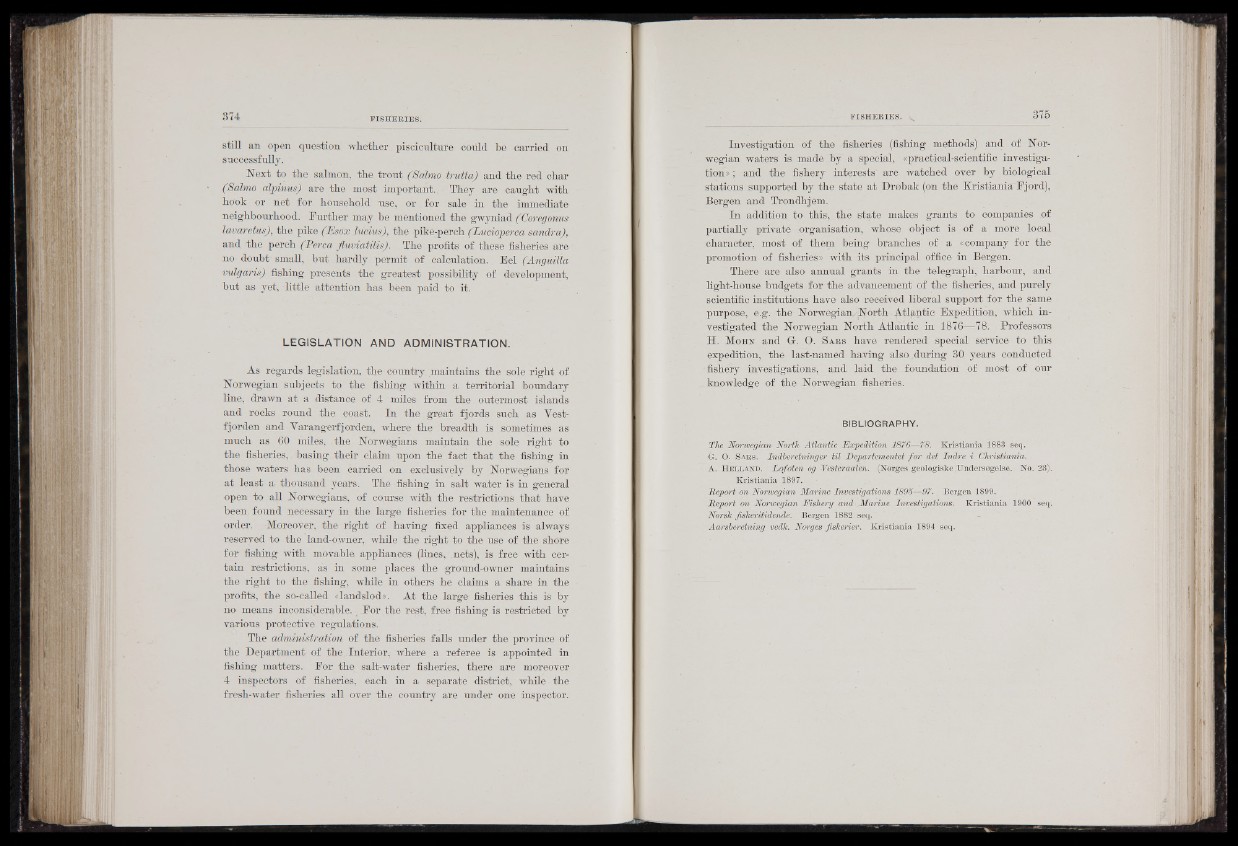
still an open question whether pisciculture could be carried on
successfully.
Next to the salmon, the trout (Salmo trutta) and the red char
(Salmo alpinus) are the most important.. They are caught with
hook or net for household use, or . for sale in the immediate
neighbourhood. Further may be mentioned the gwyniad (Coregonus
lavaretm), the pike (Esox lucius), the pike-perch (Lueioperca sandra),
and the perch (Perea fluviatilis). The profits of these fisheries are
no doubt' small, but hardly permit of calculation. Eel (Anguilla
vulgaris) fishing presents the greatest possibility of development,
but as yet, little attention has been paid to it.
LEGISLATION AND ADMINISTRATION.
As regards legislation, the country, maintains the sole right of
Norwegian subjects to the fishing within a territorial boundary
line, drawn at a distance of 4 miles from the outermost islands
and rocks round the coast. In the great fjords such as Vest-
fjorden and Varangerfjorden, where the breadth is sometimes as
much as 60 miles, the Norwegians maintain the sole right to
the fisheries,. basing their claim upon the fact that the fishing in
those waters has been carried on exclusively by Norwegians for
at least a thousand years. The fishing in salt water is in general
open to all Norwegians, of course with the restrictions that have
been found necessary in the large fisheries for the maintenance of
order. Moreover, the right of having fixed appliances is always
reserved to the land-owner, while the right to the use of the shore
for fishing with movable appliances (lines, .nets), is free with certain
restrictions, as in some places the g r o u n d - o w n er maintains
the right to the fishing, while in others he claims a share in the
profits, the so-called «landslod». At the large fisheries this is by
no means inconsiderable. . For the rest, free fishing is restricted by
various protective regulations.
The administration, of the fisheries falls under the province of
the Department of the Interior, where , a referee is appointed in
fishing matters. For the salt-water' fisheries, there are moreover
4 inspectors of fisheries, each in a separate district, while the
fresh-water fisheries all over the country are under one inspector.
Investigation of the fisheries (fishing methods) and of Norwegian
wafers is made by a special, «practical-scientific investigation
» ; and the fishery interests' are watched over by biological
stations supported by the state at Drobak (on the KristianiaFjord),
Bergen and Trondhjem.
In addition to this, the state makes grants to companies of
partially private organisation, whose object is of a more local
character, most of them being branches of a «company for the
promotion of fisheries» with its principal office in Bergen.
There are also annual grants in the telegraph, harbour, and
light-house budgets for the advancement of the fisheries, and purely
scientific institutions have also received liberal support for the same
purpose, e.g. the Norwegian/North Atlantic Expedition, which investigated
the Norwegian North Atlantic in 1876—78. Professors
H . M o o t and G. 0. S ars have rendered special service to this
expedition, the last-named having also , during 30 years conducted
fishery investigations," and laid the foundation of most of our
knowledge of the Norwegian fisheries.
BIBLIOGRAPHY.
The Norwegian North Atlantic Expedition 1876—78. Kristiania 1883 seq.
G . O . S a u s . Indberetninger til JDepartementet fo r det Indre i Christiania.
A. H k l l a k d . Lofoten og Vester aalen. (Norges geologiske Tindersegelse. No. 2 3 ) .
Kristiania 1897.
Report on Norwegian Marine Investigations 1895—97. Bergen 1899.
Report on Norwegian Fishery and Marine Investigations. Kristiania 1900 seq.
Norsk fiskeritidende. Bergen 1882,_seq.
Aarsberetning vedk. Norges Jiskerier. Kristiania 1894 seq..